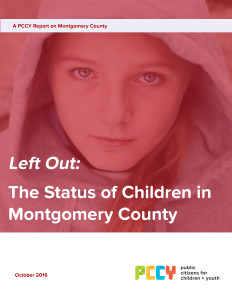Children Still in Recession in Montgomery County Despite Recovery
Rising child poverty and lower student achievement casts shadow over modest gains
 Philadelphia (Oct 20, 2016) – While recent headlines tout a national recovery from the Great Recession, more children in Montgomery County are facing hardships than during the depths of the recession, a new study has found.
Philadelphia (Oct 20, 2016) – While recent headlines tout a national recovery from the Great Recession, more children in Montgomery County are facing hardships than during the depths of the recession, a new study has found.
Public Citizens for Children and Youth [PCCY] announced new comprehensive reports on the status of children in Montgomery, Montgomery, Bucks and Chester counties, entitled, “Left Out.” The Montgomery County report was released today.
“An American tragedy is happening right before our eyes, yet it’s very hard to see. The headline news touts a strong economic recovery, and monthly jobs reports amplify that message. But PCCY dug into the data and in Montgomery County found a very different and alarming story that does not bode well for children or the county,” said Donna Cooper, Executive Director of Public Citizens for Children and Youth.
The new PCCY “Left Out” series unveils a Child Wellness Index that measures whether children are worse off or better with respect four domains: K-12 education, early childhood education, health and economic well-being. Compared to 2008 when the recession was just beginning, children in Montgomery County are faring worse in the economic well-being domain. There was minimal improvement in the early childhood and K-12 education domains, while their health status has improved considerably.
“It’s pretty startling that in eight of the 16 Index measures, children were faring worse in Montgomery County compared to 2008. Even where children are doing better, thousands of children are up against very bad odds,” said Cooper.
Economic Rebound Still Not Reaching Children
“The economy may be improving, but our clients are still struggling to make ends meet. Even though most of them work, their salary is still too low to even cover their basic needs. They have to choose between paying the bills and feeding their families. Poverty is a real, tangible life experience for most of these families and their children.” – Nelly Jimenez-Arevalo, Executive Director and CEO of ACLAMO Family Centers
- Five years after the recession (2015), Montgomery County’s child poverty rate finally dropped slightly below the 2008 level, but still 7.1%, or 12,513 children, are living in poverty. To put that number in perspective, the number of children in poverty in Montgomery County would fill every seat in Villanova Stadium.
- Among the children in poverty, slightly more than 5,800 are living in families earning less than half of the poverty level ($10,000 or less per year for a family of three). That’s about the same number of children as are enrolled in the Perkiomen Valley School District.
Most School Districts Have Less Funds Even With More Students Who Need Extra Help
“We have some terrific school districts in Chester County, but each year we see more children who need extra help to succeed. And our ability to help them is hampered by a broad range of unfunded mandates and the state’s resistance to putting up its fair share of public school funding. That’s one reason we’ve seen district budgets across the county that require tax increases. As a school board member I know how hard it is to ask our neighbors to pay more in taxes. But we have little choice. We work very hard to run our district as efficiently as possible to keep taxes down. But I know that if a tax increase is necessary to ensure a high quality education, we have to do so.” – Kate Shaw, School Board Director of West Chester Area School District
- The elimination of Stimulus state and federal aid in FY 2011 led to spending declines in most districts, averaging $3,600 per classroom by 2015, despite local tax increases in every district. The districts hardest hit were those educating the largest share of low-income students; they had on average $8,000 less per classroom.
- As a result, student performance declined. More than 8,400 public school students in the county could not pass state reading assessments in 2014, a full 18% of all students in the county. This fail rate is one point higher than in 2008. The fail rate for math didn’t increase but remained stubbornly high at 14%.
Access to Quality Early Learning Experiences Improved, But Most Poor Children Still Not Given this Smart Start
“Thousands of working parents seek our help; they are spending a significant amount of their incomes on childcare, but still find their options limited choices because of a shortage of affordable, quality care in their community. The County works hard to close gaps for vulnerable families, but overall the solutions are complex and it will take coordinated effort and much greater resources at state and national levels. If we fail to grapple with this now, the result will be that we perpetuate the lack of opportunity that will influence children’s futures.” – Elizabeth Adeyi, Executive Director of the Child Care Information Services of Montgomery County
- Young families are struggling with the rising costs of child care in Montgomery County, where three out of four children under six years old have all parents in the workforce. Full-time childcare for two children (a preschooler and an infant) totaled $25,220, or nearly a third of the county’s median household income.
- More children in publicly subsidized child care were in high quality programs in 2014 compared to 2008, but still 70% cannot get access to those programs due to shortages in public funds. Meanwhile fewer children were able to enroll in publicly funded pre-k, with four out of five eligible children in the county unable to enroll in high quality pre-k due to lack of public funding.
The Health Status of Children Made Greatest Gains, but the Poorest Children Show Real Signs of Trouble
“It’s a situation I see far too frequently in my line of work. Children are brought into the hospital needing care for a health issue that has become serious and could have been prevented by seeking medical attention much earlier, but they have no health insurance. There is compelling medical, social and economic evidence to expand CHIP to cover children who are undocumented – but I also support expansion because it’s the right thing to do.” – Dr. Stephen A. Shapiro, D.O., Chair, Pediatrics Department, Abington – Jefferson Health
- The strongest public policy that protected children during the recession was the availability of state and federally subsidized health care coverage for children. In spite of job losses and cuts to employee benefit packages during the recession, the share of children insured rose slightly from 2008 to 2014 to 97% thanks to CHIP and Medicaid. Still, more than 5,600 children are uninsured, and many of them don’t have the option to enroll in publicly subsidized programs because of the state’s ban on undocumented children’s access to such health care supports.
- Racial health disparities have persisted since 2008. The county’s infant mortality rate rose to 5.5 deaths per 1,000 births, and the rate for black infants stood at 17.4 – four times the rate for white infants. Black children were also hospitalized for asthma at four times the rate of white children.
Public Policy Helped Reduce Senior Poverty but Didn’t Do So for Children
- In every county, the economic recession affected thousands of children and seniors, increasing the numbers in poverty at its low point. But unlike seniors, where effective public policies helped them recover more quickly in every suburban county, children were not afforded the same protections. These policies include Medicare, Social Security, Pennsylvania State Prescription Coverage (PACE), Pennsylvania Property Tax and Rent Rebates and state tax policies that exclude retirement earnings from state taxation.
- The child poverty rate has been higher than the senior poverty rate every year since 2008 in Montgomery County. In 2013, the senior poverty rate began to decline, a full year earlier than the child poverty rate.
“These reports show good public policies are highly effective at changing life outcomes for children—in many instances they are the only tools that make a difference,” said Cooper. “Elected officials and their constituents have the opportunity to build the public will to adopt policies that protect children and strengthen the prospects of Montgomery County.”
Policy Recommendations
- Boost Job Longevity and Pay: Increase the minimum wage and implement workforce supports including predictable scheduling and paid sick and family leave.
- Increase Household Income: Connect families to federal income and work supports like the Earned Income Tax Credit, Child Tax Credit and SNAP.
- Feed Hungry Children: Expand participation in the school meals program.
- Ensure Health Care Access: Expand public health insurance to undocumented children.
- Reduce Infant Mortality: Ensure Medicaid and CHIP providers implement strategies to boost pre and postnatal care utilization among black women.
- Eliminate Child Lead Poisoning: Ensure that publicly funded health providers test every child under three; remediate homes of pregnant women at high risk for lead hazards.
- Increase School Attendance: Improve how public health providers address asthma, including home visits to reduce home-based asthma triggers.
- Cut the Teen Pregnancy Rate Further: Increase access to long acting birth control for teens with Medicaid.
- Expand the Reach of Early Intervention: Expand the use of early screening tools to identify all children in need of early intervention services.
- Make Quality Child Care Affordable: Use state and county resources to incentivize providers to improve quality and enable providers that are already high quality to expand.
- Expand Pre-K: Increase state investment in pre-k to create a seat for every eligible child.
- Grow Access to Full Day Kindergarten: Remove financial barriers that limit school districts’ ability to provide full day kindergarten.
- Address the School Funding Crisis: Increase state funds for public schools and distribute those funds through the Basic Education Funding Formula.
Links and Graphics
See the full Montgomery County report at: https://www.childrenfirstpa.org/wp-content/uploads/2016/10/Left-Out_Montgomery-County.pdf
See and share Montgomery County indicators graphics at: https://www.childrenfirstpa.org/?post_type=resource&p=6378
See reports from all five counties at: https://www.childrenfirstpa.org/report/left-regional-reports-child-well/
